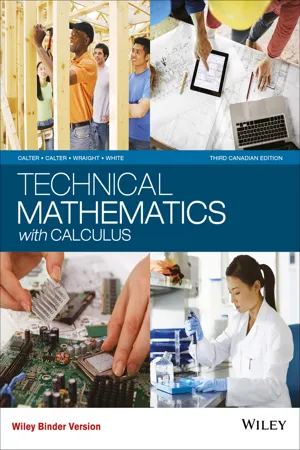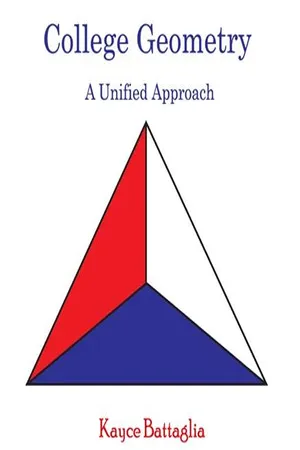Mathematics
Angles in Polygons
Angles in polygons refer to the interior angles formed within a closed shape with straight sides. The sum of the interior angles in any polygon can be found using the formula (n-2) * 180 degrees, where n represents the number of sides. Understanding the relationship between the number of sides and the total interior angles is crucial in geometry and trigonometry.
Written by Perlego with AI-assistance
Related key terms
1 of 5
8 Key excerpts on "Angles in Polygons"
- eBook - PDF
- Michael A. Calter, Paul A. Calter, Paul Wraight, Sarah White(Authors)
- 2016(Publication Date)
- Wiley(Publisher)
6-19. The points where the sides meet are called vertices. We say that the sides of a polygon are equal if their measures (lengths) are equal. If all of the sides and angles of a polygon are equal, it is called a regular polygon, as in Fig. 6-20. The perimeter of a polygon is simply the sum of its sides. Modern definitions of plane figures don’t include the interior as part of the figure. Thus in Fig. 6-20, point A is not on the square, while point B is on the square. The interior is referred to as a region. Regular Heptagon Regular Nonagon Regular Decagon Regular Octagon Interior angle Vertex Side FIGURE 6-19 A polygon Equilateral triangle Square Regular Hexagon Regular Pentagon B A FIGURE 6-20 Some regular polygons Sum of Interior Angles A polygon of n sides has n interior angles, such as those shown in Fig. 6-21. Their sum is equal to the following: Interior Angles of a Polygon Sum of angles = (n - 2)180° 112 99° 123° 62° 278° 226° 43° θ FIGURE 6-21 ◆◆◆ Example 4: Find angle θ in Fig. 6-21. Solution: The polygon shown (a heptagon) in Fig. 6-21 has seven sides, so n = 7. Using our equation for sum of interior angles (Eq. 112), let’s take a step approach. TABLE 6-2 Calculating the Interior Angle of a Polygon Step # Instruction Solution Step 1 Calculate what the sum of the interior angles should be. Sum of angles = (7 - 2) 180° = 900° Step 2 Add the six interior angles that we are given. 278° + 62° + 123° + 99° + 226° + 43° = 831° Step 3 Subtract the sum of the six interior angles we are given from what the sum of the interior angles should be. θ = 900° - 831° = 69° ◆◆◆ 131 Section 6–3 ◆ Triangles Exercise 2 ◆ Polygons 1. Calculate the sum of interior angles for the following regular polygons: (a) Triangle (b) Quadrilateral (c) Pentagon (d) Hexagon (e) Heptagon (f) Octagon (g) Nonagon (h) Decagon 2. Find the missing interior angle for the following irregular polygons: 6–3 Triangles Triangles are polygons with three sides. - Alan Tussy, Diane Koenig(Authors)
- 2018(Publication Date)
- Cengage Learning EMEA(Publisher)
Due to electronic rights, some third party content may be suppressed from the eBook and/or eChapter(s). Editorial review has deemed that any suppressed content does not materially affect the overall learning experience. Cengage Learning reserves the right to remove additional content at any time if subsequent rights restrictions require it. 9.3 • Polygons and Triangles 733 Pierdelune/Shutterstock.com The House of the Seven Gables, Salem, Massachusetts OBJECTIVE 1 Classify polygons. Polygon A polygon is a closed geometric figure with at least three line segments for its sides. Polygons are formed by fitting together line segments in such a way that n no two of the segments intersect, except at their endpoints, and n no two line segments with a common endpoint lie on the same line. The line segments that form a polygon are called its sides. The point where two sides of a polygon intersect is called a vertex of the polygon (plural vertices). The polygon shown to the right has five sides and five vertices. Polygons are classified according to the number of sides that they have. For example, in the figure below, we see that a polygon with four sides is called a quadrilateral, and a polygon with eight sides is called an octagon. If a polygon has sides that are all the same length and angles that are the same measure, we call it a regular polygon. Triangle 3 sides Quadrilateral 4 sides Pentagon 5 sides Hexagon 6 sides Heptagon 7 sides Polygons Octagon 8 sides Nonagon 9 sides Decagon 10 sides Dodecagon 12 sides Regular polygons Vertex Vertex Vertex Vertex Vertex Side Side Side Side Side OBJECTIVES 1 Classify polygons. 2 Classify triangles. 3 Identify isosceles triangles. 4 Find unknown angle measures of triangles. SECTION 9.3 Polygons and Triangles We will now discuss geometric figures called polygons. We see these shapes every day. For example, the walls of most buildings are rectangular in shape. Some tile and vinyl floor patterns use the shape of a pentagon or a hexagon.- No longer available |Learn more
College Geometry
A Unified Approach
- (Author)
- 2014(Publication Date)
- Orange Apple(Publisher)
________________________ WORLD TECHNOLOGIES ________________________ Chapter- 5 Polygon and Circle Polygon An assortment of polygons In geometry a polygon is traditionally a plane figure that is bounded by a closed path or circuit , composed of a finite sequence of straight line segments (i.e., by a closed polygonal chain). These segments are called its edges or sides , and the points where two edges meet are the polygon's vertices or corners . An n -gon is a polygon with n sides. The interior of the polygon is sometimes called its body . A polygon is a 2-dimensional example of the more general polytope in any number of dimensions. The word polygon derives from the Greek πολύς (many) and γωνία (gōnia), meaning knee or angle. Today a polygon is more usually understood in terms of sides. Usually two edges meeting at a corner are required to form an angle that is not straight (180°); otherwise, the line segments will be considered parts of a single edge. The basic geometrical notion has been adapted in various ways to suit particular purposes. For example in the computer graphics (image generation) field, the term polygon has taken on a slightly altered meaning, more related to the way the shape is stored and manipulated within the computer. ________________________ WORLD TECHNOLOGIES ________________________ Classification Number of sides Convexity Polygons may be characterised by their degree of convexity: • Convex : any line drawn through the polygon (and not tangent to an edge or corner) meets its boundary exactly twice. In other words, all its interior angles are less than 180°. • Non-convex : a line may be found which meets its boundary more than twice. In other words, it contains at least one interior angle with a measure larger than 180°. • Simple : the boundary of the polygon does not cross itself. All convex polygons are simple. • Concave : Non-convex and simple. • Star-shaped : the whole interior is visible from a single point, without crossing any edge. - No longer available |Learn more
- (Author)
- 2014(Publication Date)
- Library Press(Publisher)
________________________ WORLD TECHNOLOGIES ________________________ Chapter 5 Polygon and Circle Polygon An assortment of polygons In geometry a polygon is traditionally a plane figure that is bounded by a closed path or circuit , composed of a finite sequence of straight line segments (i.e., by a closed polygonal chain). These segments are called its edges or sides , and the points where two edges meet are the polygon's vertices or corners . An n -gon is a polygon with n sides. The interior of the polygon is sometimes called its body . A polygon is a 2-dimensional example of the more general polytope in any number of dimensions. The word polygon derives from the Greek πολύς (many) and γωνία (gōnia), meaning knee or angle. Today a polygon is more usually understood in terms of sides. Usually two edges meeting at a corner are required to form an angle that is not straight (180°); otherwise, the line segments will be considered parts of a single edge. The basic geometrical notion has been adapted in various ways to suit particular purposes. For example in the computer graphics (image generation) field, the term polygon has taken on a slightly altered meaning, more related to the way the shape is stored and manipulated within the computer. ________________________ WORLD TECHNOLOGIES ________________________ Classification Number of sides Convexity Polygons may be characterised by their degree of convexity: • Convex : any line drawn through the polygon (and not tangent to an edge or corner) meets its boundary exactly twice. In other words, all its interior angles are less than 180°. • Non-convex : a line may be found which meets its boundary more than twice. In other words, it contains at least one interior angle with a measure larger than 180°. • Simple : the boundary of the polygon does not cross itself. All convex polygons are simple. • Concave : Non-convex and simple. • Star-shaped : the whole interior is visible from a single point, without crossing any edge. - eBook - PDF
- John Peterson, Robert Smith(Authors)
- 2018(Publication Date)
- Cengage Learning EMEA(Publisher)
Examples of polygons are shown in Figure 24–1. a b c d e f g Figure 24–1 24–1 TYPES OF POLYGONS A convex polygon is a polygon in which no side, if extended, cuts inside the polygon. In Figure 24–1, polygons a through e are convex. In this book, unless otherwise stated, the word polygon means convex polygon. A concave polygon is a polygon in which two or more sides, if extended, cut inside the polygon. In Figure 24–1, polygons f and g are concave. An equilateral polygon is a polygon with all sides equal. In Figure 24–1, polygons a , c , and e are equilateral. UNIT 24 POLYGONS Copyright 2019 Cengage Learning. All Rights Reserved. May not be copied, scanned, or duplicated, in whole or in part. Due to electronic rights, some third party content may be suppressed from the eBook and/or eChapter(s). Editorial review has deemed that any suppressed content does not materially affect the overall learning experience. Cengage Learning reserves the right to remove additional content at any time if subsequent rights restrictions require it. 598 Section IV FUNDAMENTALS OF PLANE GEOMETRY An equiangular polygon is a polygon with all angles equal. In Figure 24–1, poly-gons a , b , c , and e are equiangular. In Figure 24–2, polygon b is equiangular. A regular polygon is a polygon that is both equilateral and equiangular; all sides and all angles are equal. In Figure 24–1, polygons a , c , and e are regular. In Figure 24–2, polygon c is regular. Except in the case of triangles, a polygon can be equilateral without being equi-angular and equiangular without being equilateral. This fact is shown by polygons a and b in Figure 24–2. s s s s s s a. EQUILATERAL ALL SIDES EQUAL ALL ANGLES NOT EQUAL a 8 b. EQUIANGULAR ALL ANGLES EQUAL ALL SIDES NOT EQUAL a 8 a 8 a 8 a 8 a 8 a 8 c. REGULAR ALL SIDES EQUAL ALL ANGLES EQUAL a 8 a 8 a 8 a 8 a 8 s s s s s s Figure 24–2 Polygons are often classified according to their number of sides. - eBook - ePub
- Douglas K. Brumbaugh, Peggy L. Moch, MaryE Wilkinson(Authors)
- 2004(Publication Date)
- Routledge(Publisher)
at F. The sides of ABCD are congruent in pairs, thus you will see that the height of the polygon depends on your orientation as you view the sketch.Your Turn 15. Write an informal definition for each term. a) Side of a polygon—How many sides does a 12-gon have? b) Vertices of a polygon—How many vertices does a 7-gon have? c) Diagonal of a polygon—How many diagonals does a 5-gon have? d) Altitude of a polygon—How many altitudes does a 3-gon have? CirclesFig. 4.17.Some people consider a circle to be a special polygon—with an infinite number of infinitely short sides. Others prefer to put the circle in a special category all its own. Because a circle is a simple closed curve, it divides the plane into three sets of points (inside the circle, outside the circle, and on the circle). When you used a piece of string to model the polygons in Table 4.1 , did your model start to look a bit like a circle as you added more and more sides without changing the length of the string? It is easy to see the connection with polygons. However, as you look at circles, such as the one shown in Fig. 4.18 , you do not see infinitely short sides, only smooth and perfectly rounded curves, making it easy to argue that circles should have their own category.Fig. 4.18.Sometimes people refer to circular pieces of material as circles—perhaps a coin, poker chip, or other disk. In fact, these items are right circular cylinders; they may be very short cylinders, but they are not figures in a plane and they have more dimensions than do circles. A circle is a point and every member of the set of points is the exact same distance from the center in the plane. The circular array of points is the circumference of the circle. The circle is the ring. The set of points inside the ring is not the circle; it is the interior of the circle. Similarly, the points outside the ring are not the circle; they make up the exterior of the circle. A circle has no substance, so the best way to model a circle is with a wire ring. Of course, the wire of the ring has thickness, but it represents a much better model of a circle than a solid plastic disk. - eBook - PDF
- Karl Smith(Author)
- 2016(Publication Date)
- Cengage Learning EMEA(Publisher)
Illustration by Slim Films. FIGURE 7.32 A sample golygon Triangles 7.3 One of the most frequently encountered polygons is the triangle. In this section, we take a closer look at them. Terminology Every triangle has six parts: three sides and three angles. We name the sides by naming the endpoints of the line segments, and we name the angles by identifying the vertex (see Figure 7.33). A B C Sides Angles AC A CB B AB C FIGURE 7.33 A standard triangle showing the six parts Triangles are classified both by sides and by angles (single, double, and triple marks are used to indicate segments of equal length): A triangle and the parts of a triangle are essential ideas. Copyright 2017 Cengage Learning. All Rights Reserved. May not be copied, scanned, or duplicated, in whole or in part. Due to electronic rights, some third party content may be suppressed from the eBook and/or eChapter(s). Editorial review has deemed that any suppressed content does not materially affect the overall learning experience. Cengage Learning reserves the right to remove additional content at any time if subsequent rights restrictions require it. Section 7.3 Triangles 345 By Sides By Angles Scalene triangle: No equal sides Acute triangle: Three acute angles Scalene triangle Acute triangle Isosceles triangle: Two equal sides Right triangle: One right angle Isosceles triangle Right triangle Equilateral triangle: Three equal sides Obtuse triangle: One obtuse angle Equilateral triangle Obtuse triangle We say that two triangles are congruent triangles if they have the same size and shape. Suppose that we wish to construct a triangle with vertices D , E , and F , congruent to D ABC as shown in Figure 7.33. We would proceed as follows (as shown in Figure 7.34): 1. Mark off segment DE so that it is congruent to AB . We write this as DE . AB . 2. Construct angle E so that it is congruent to angle B . We write this as / E . / B . 3. Mark off segment EF . - eBook - PDF
Geometry
A Self-Teaching Guide
- Steve Slavin, Ginny Crisonino(Authors)
- 2004(Publication Date)
- Wiley(Publisher)
3x x a e g 65° f h c d 40° n p l k o q m a b d c The Basics 19 ANSWERS 1. a. B b. S c. N d. W e. E f. B 2. a. right b. obtuse c. straight d. acute e. straight f. acute 3. a. adjacent b. adjacent c. adjacent, complementary d. adjacent, supplementary e. adjacent, supplementary f. adjacent 4. a. 360° b. 180° c. 180° d. 180° 5. k = 140° 1 = 140° m = 40° n = 40° o = 140° p = 140° q = 40° 6. a = 115° c = 65° d = 115° e = 115° f = 65° g = 65° h = 115° 7. 3x + x = 180° 4x = 180° x = 45° Polygons A polygon is a closed planar figure that is formed by three or more line segments that all meet at their end points; there are no end points that are not met by another end point. Two of the most common polygons are triangles (to which we’ve devoted all of the next chapter) and quadrilaterals. Quadrilaterals are four-sided figures. Shown below are the four most common quadrilaterals. A square is a quadrilateral that consists of all right angles and equal sides. A rectangle is a quadrilateral that consists of four right angles where opposite sides are parallel and equal in length. A trapezoid is a quadrilateral with exactly one pair of parallel sides. A parallelogram is a quadrilateral with both pairs of opposite sides parallel. a. b. rectangle square 20 GEOMETRY c. d. All quadrilaterals contain 360°. The square and the rectangle each contain four angles of 90°. The trapezoid and the parallelogram each contain two angles of more than 90°. A few pages back we said that supplementary angles could be adjacent or nonadjacent. Trapezoids contain two sets of nonadjacent supplementary angles. So, too, do parallelograms. The following illustrations show an example of each. How many degrees are angles A, B, and C in each of the following polygons? In the figure, the trapezoid contains angles A (60°), B (120°), and C (120°). The parallelogram contains angles A (130°), B (50°), and C (130°).
Index pages curate the most relevant extracts from our library of academic textbooks. They’ve been created using an in-house natural language model (NLM), each adding context and meaning to key research topics.







